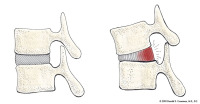Lifting techniques are essential to maintain a healthy back. Many individuals have heard me state ad nauseum, NO BLT, NO BLT, NO BLT!!!!!!!!! For those of you who don’t already know, BLT is bend, twist and lift (at the same time). This one position is responsible for most injuries to the lower back. It turns out the disc is 50% weaker when twisting due to its design (see anatomy section). When you then bend over, the back wall of the disc (the annulus) is stretched putting it under tension. You increase the tension by loading the spine (lifting). This is a dangerous state where the fibers can tear.
Adding insult to injury, the further away the load is from your center of gravity, the greater the stress is on the back wall of the disc (remember high school physics- the laws of levers and fulcrums).
The problem is that the bad type of lifting (BLT) is easier- that is- it takes less energy to lift using the BLT technique than an appropriate safe technique (shoulders square to the load, lift with your legs, keep the weight next to your body, move with your legs). Training takes time to eliminate the bad habits gained since you were six years old. This is where a good physical therapist or chiropractor is worth their weight in gold- retraining you to eliminate the bad habits and lift properly.
You can also see that when you are tired, you may revert back to the old habits as BLT lifting expends so much less energy. This is the exact wrong time to start lifting like that as the muscle strength that is so necessary to prevent injuries is at its lowest. NO BLT, NO BLT, NO BLT!!!!

(Click to Enlarge Image) These diagrams on the bottom demonstrate improper (left) and proper (right) lifting techniques. Keeping the weight close to your body significantly reduces the stress on the back. The diagrams above the stick figures show with the fulcrum and levers how much more stress is applied to the back muscles with lifting away from the center of gravity.

(Click to Enlarge Image) This illustration demonstrates the stresses on the back wall of the disc with standing relaxed and with flexion (bending forward). With forward bending, the back wall of the disc is stretched. With any significant load (lifting), the fibers are tensioned and can tear.

(Click to Enlarge Image) This illustration demonstrates the anatomy of the annulus. The annulus is made up of about 30 rings of collagen- just like plies of a tire. You can see that the orientation of the fibers alternate with each layer. This makes for a strong and redundant disc wall when the spine is in neutral but with twisting (rotation), half of the fibers undergo tension and the other half become relaxed. The picture on the lower right demonstrates this phenomenon. Rotation of the spine therefore weakens the disc wall and it becomes more susceptible to tearing. Moral of the story- don’t twist when you lift!
